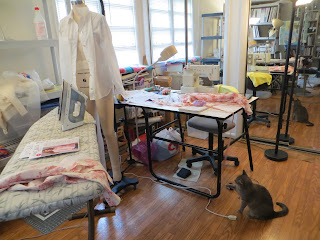Dedico este blog a mi gran amigo Jonatán en la ciudad de Córdoba, Argentina. Jonatán cultiva su jardíncito, de su proprio iniciativo, para dar comida a su familia.
Jonatán, por supuesto puedes hallar mucha información sobre compostaje en la red, pero prefiero darte informaciones más personal, de mis experiencias haciendo mi proprio compost por muchos años. Lo hago porque es abono limpio, sin sustancia química. Además, me da mucho placer hacerlo. Parece que todavía soy niña que quiere ensuciar sus manos jugando en la tierra!
Para comenzar con foto #1, se ve abono "vivo," plantas que se puede desarraigar, y despues socavar en la tierra. Hago esto después de unas estaciones, para dar de nuevo nutrientes a la tierra.
Foto #5 Comida incomible de la cocina (se puede poner el mate!). Kitchen waste
Foto#6 Aquí se pone todo! Put everything in here!
Una parte de mi composto se hace en un receptáculo de plástico. Pongo dentro malas hierbas del jardín y comida incomible de la cocina. ( Fotos #2, 3, 4, y 5)
En cuanto a las malas hierbas, es MUY IMPORTANTE recordar de no poner: plantas con semillas ni plantas con enfermedads, como fungo. Y en cuanto a la comida incomible de la cocina, no poner: carne, huesos, o cosas ya cocidas. Cáscaras de huevo son muy amadas de las lombrices. Te, café y maté también.Todo se pone en el receptáculo grande de compost, foto #6. La próxima etapa es girar el compostaje cada 2-3 semanas, poniendo lo de arriba en la tierra para formar el montón de nuevo. Al fondo del montón original, habrá tierra negra y fino. Esta es el compostaje bien "cocinado," o terminado, como se puede ver en foto #7. Este pongo en otro receptáculo para continuar a "cocinar" durante los meses fríos, para usar cuando comienza la estación de cultivación.
El segundo tipo de composto es algo muy común en el este de los Estados Unidos: hojas! Compré seis graneros para hojas. (Foto #8) Las colecciono en el otoño, cuando caen, y las pongo en la tierra entre las plantas para impedir la salida de malas hierbas. Y, a la vez, las hojas son perfectas para nutrir la tierra. Al fondo de los graneros hay tambien compostaje de hojas que parece tierra negra y fino. (Foto #9) Este tesoro mezclo con el otro compostaje para abono "super." Produce plantas fantásticas también! (Fotos #10 y 11.)
Pues, ya ven que soy una compostadora fanática! Pero vale la pena en cuanto al salud de la familia y el sabor de las hortalizas. Buena suerte, y buen provecho!
Foto #1 Abono vivo. Cover crops to replenish nutrients
Foto #2 Contenador de plástico para compost Plastic composter
Foto #3 Malas hierbas Weeds
Foto #4 Receptáculo para comida incomible de la cocina Kitchen composter
Foto#7 Compostaje terminado. Finished compost
Foto #8 Graneros de hojas. Leaf bins
Foto #9 Compostaje de hojas, bien terminado. Leaf mold.
Foto #10 Nabos! Turnips!
Foto #11 Col rizado, o "kale"
ENGLISH TRANSLATION
I dedicate this blog to my great friend Jonatán in the city of Córdoba, Argentina, who cultivates his small garden, all on his own initiative, to give fresh vegetables to his family.
Jonatan, of course you can find a lot of information about composting on the Internet, put I prefer to give you more personalized tips from my many years of making my own compost. I do it myself because it's "clean fertilizer," without any chemicals. Also, it is great fun to make it. It seems that I'm still a little kid who wants to get her hands dirty playing in the dirt!
Starting with photo #1, you can see "cover crops," which are plants which you dig up and then bury in the soil. I plant these after a few season to return nutrients to the soil.
One part of my compost is made in a round plastic container. I put weeds and kitchen scraps in it. (Photos #2, 3, 4, and 5)
Regarding the weeds, it's very important to remember not to put in any plants with seeds, or any plants with diseases, such as fungal infections. And when using kitchen scraps, remember to leave out bones, meat, or anything that's already been cooked. Worms love eggshells, as well as tea, coffee grounds, and mate. Everything allowable is put into the big plastic composter, photo #6. The next step is to turn the compost pile every 2-3 weeks, putting the stuff on the top on the ground next to the original pile to form a new pile. At the bottom of the original pile, there will be fine black soil. This is "finished compost," which you can see in photo #7. I put this in another container to continue to "cook" during the cold months, in order to use it when the new planting season begins.
The second type of compost is something very commonly found in the Eastern United States: leaves! I bought six leaf bins. (Photo #8) I gather the leaves in the autumn, and put them on the ground between the newly-growing plants in the spring and summer to impede weed growth. And, at the same time, leaves are perfect soil nutrients. At the bottom of the leaf bins, there is also leaf compost that looks like fine black soil. This is leaf mold, a treasure shich I mix with the other compost to make a "super fertilizer." It produces fantastic plants!
Well, now it's obvious that I'm a compost fanatic. But it's worth it for our families' health and the taste of the vegetables. Good luck and bon apetit!



























